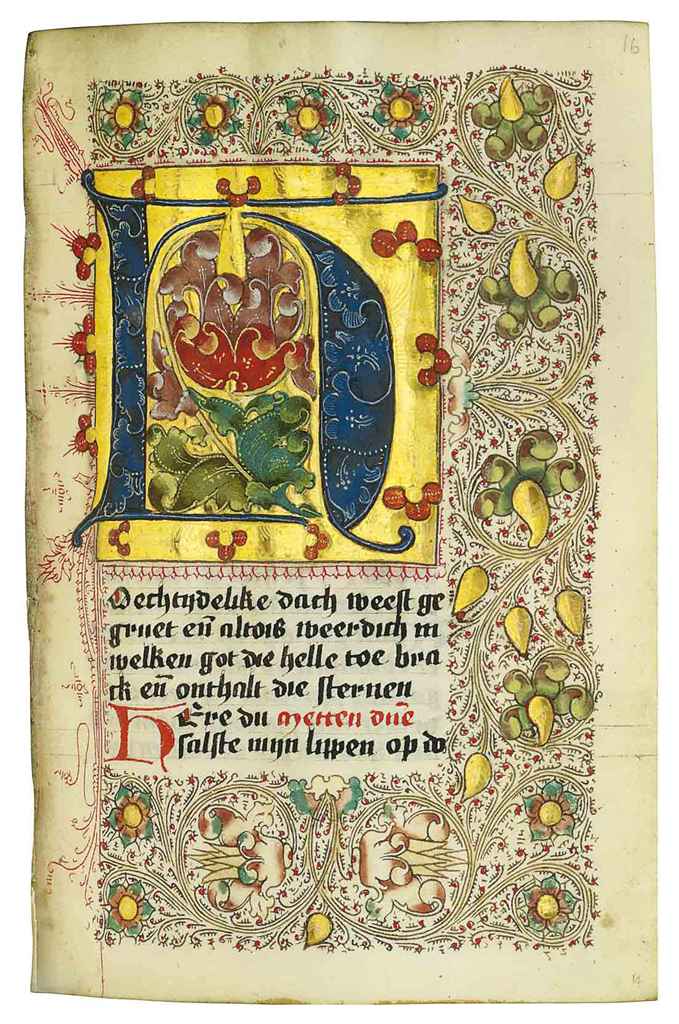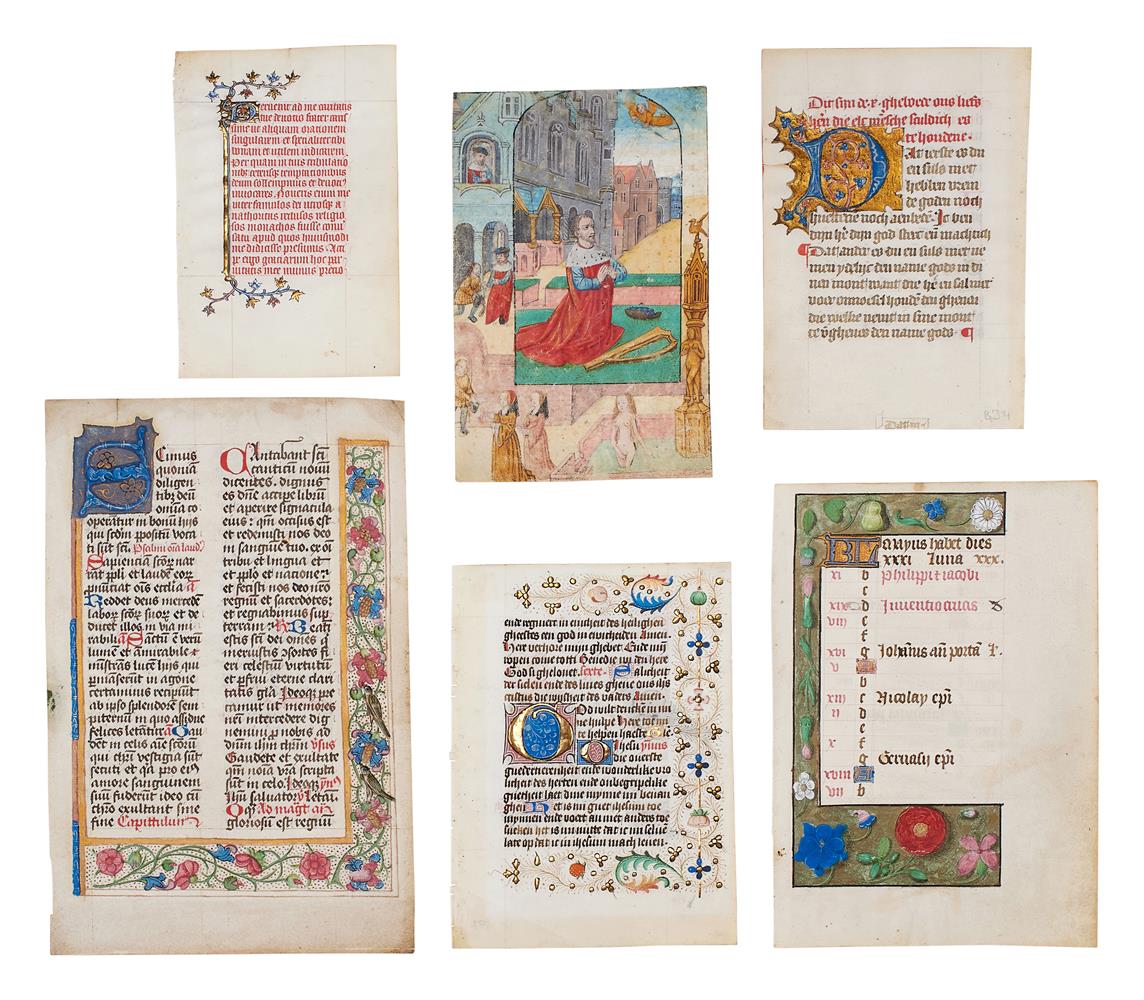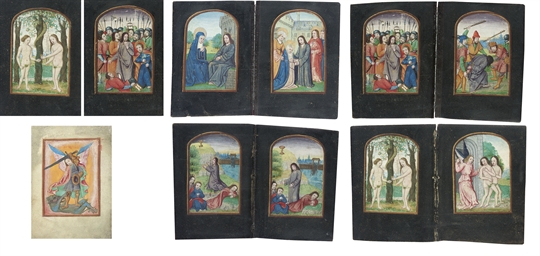PRAYERBOOK, in Dutch, ILLUMINATED MANUSCRIPT ON VELLUM Stein, near Gouda, dated 1537 134 x 95mm. i paper + 180 + i paper leaves: 1 7(of 8, lacking ii), 2-8 8, 9 7(of 8, lacking vii), 10-17 8, 18 7(of 8, lacking iii), 19-21 8, 22 1(of 2, lacking ii), 23 6, 24 7(of 8, viii cancelled blank), 16 lines written in black ink in a gothic bookhand between two verticals and 17 horizontals ruled in grey, pricking for both horizontals and verticals, justification: 94 x 58mm, rubrics in red, text capitals touched red, one- and two-line initials alternately in red and blue, 13 three- to four-line initials in burnished gold on grounds of blue or pink, flourished into the margin in blue or pink, TWO LARGE INITIALS IN BURNISHED GOLD ON BLUE GROUNDS WITH FULL BORDERS OF NATURALISTIC FRUIT AND FLOWERS WITH BIRDS on ochre grounds (lacking two leaves with miniatures and two text leaves, slight staining in some margins). 17th-century brown calf gilt with borders of floral rolls and foliate centre piece, chequered stain, spine in five compartments gilt (upper cover detached, scuffed). PROVENANCE: 1. The colophon on f.176 states that the book was written in 1537 by Heer Aernt Janssoen van Oudewater, regular at Steyn. Emmaus, the house of Augustinian canons regular at Stein near Gouda, to the west of Oudewater, was founded in 1419. Famous as the monastery reluctantly entered by Erasmus in 1485, it followed the ideals of the Devotio moderna and formed part of the Congregation of Sion which consisted predominantly of female houses. The prayer for a dying sister, f.135, shows that the book was intended for a nun, who wanted to follow the offices of Passion Week in the vernacular; the first owner may have been Suster Gherrigen Pijls, whose name is inscribed in a 16th-century hand on f.1. Sister Gerrighen may have belonged to one of the female convents of the Sion Congregation, perhaps the Margaretaklooster in Gouda. Book production was an important source of income as well as useful for supplying the Order's own needs. An earlier Diurnal from Stein with a colophon of 1448 is in the Royal Library at The Hague, ms 71 J 67. 2. 19th-century note in Dutch repeating the colophon on first paper leaf; a confused note in English connecting the book with the monastery where Erasmus died loose in volume. CONTENT: Offices and readings for Passion Week ff.1-69: Palm Sunday f.1, Maundy Thursday f.23v, Good Friday f.41v, the Passion according to John f.43, the Easter vigil (lacking end) f.63v; prayers associated with the mass ff.70-79; prayers to Christ, including the Five Wounds, 15 prayers on the Passion, the Seven Last Words, the Seven Sheddings of Blood, to be said before a crucifix and before an image of the Instruments of the Passion, to the parts of Christ's body, ff.79-109; prayers for the morning, to the Trinity, the Virgin ff.109-118; indulgenced prayers ff.118-122; prayers, including attributions to Anselm and Augustine, to be said for thirty days in times of tribulation, for a dying sister, to be said on seven Sundays for a departed soul, ff.122-141v; prayers to the Virgin, including one attributed to St Bernard, the O intemerata in Dutch, ff.141v-149; the rosary devotion known as the Psalter of the Virgin, ff.149v-167; prayers to St Anne and the Holy Kindred, including St Servatius of Maastricht, ff.167v-176. ILLUMINATION: The borders of vibrantly coloured naturalistic flowers enlivened by small birds, ff.2 and 70, are typical of the Masters of the Dark Eyes, in particular the Master of Cornelis Croesinck, whose name work was made between 1494 and 1519 for a couple probably resident at The Hague. The scatter borders, where flowers appear to have been strewn over the margins, to attract a painted fly on f.2, originated in the southern Netherlands and seem to have been introduced into Holland by this group of illuminators. The Masters of the Dark Eyes were based in the southern part of the County of Holland and this prayerbook shows their activity cont
PRAYERBOOK, in Dutch, ILLUMINATED MANUSCRIPT ON VELLUM Stein, near Gouda, dated 1537 134 x 95mm. i paper + 180 + i paper leaves: 1 7(of 8, lacking ii), 2-8 8, 9 7(of 8, lacking vii), 10-17 8, 18 7(of 8, lacking iii), 19-21 8, 22 1(of 2, lacking ii), 23 6, 24 7(of 8, viii cancelled blank), 16 lines written in black ink in a gothic bookhand between two verticals and 17 horizontals ruled in grey, pricking for both horizontals and verticals, justification: 94 x 58mm, rubrics in red, text capitals touched red, one- and two-line initials alternately in red and blue, 13 three- to four-line initials in burnished gold on grounds of blue or pink, flourished into the margin in blue or pink, TWO LARGE INITIALS IN BURNISHED GOLD ON BLUE GROUNDS WITH FULL BORDERS OF NATURALISTIC FRUIT AND FLOWERS WITH BIRDS on ochre grounds (lacking two leaves with miniatures and two text leaves, slight staining in some margins). 17th-century brown calf gilt with borders of floral rolls and foliate centre piece, chequered stain, spine in five compartments gilt (upper cover detached, scuffed). PROVENANCE: 1. The colophon on f.176 states that the book was written in 1537 by Heer Aernt Janssoen van Oudewater, regular at Steyn. Emmaus, the house of Augustinian canons regular at Stein near Gouda, to the west of Oudewater, was founded in 1419. Famous as the monastery reluctantly entered by Erasmus in 1485, it followed the ideals of the Devotio moderna and formed part of the Congregation of Sion which consisted predominantly of female houses. The prayer for a dying sister, f.135, shows that the book was intended for a nun, who wanted to follow the offices of Passion Week in the vernacular; the first owner may have been Suster Gherrigen Pijls, whose name is inscribed in a 16th-century hand on f.1. Sister Gerrighen may have belonged to one of the female convents of the Sion Congregation, perhaps the Margaretaklooster in Gouda. Book production was an important source of income as well as useful for supplying the Order's own needs. An earlier Diurnal from Stein with a colophon of 1448 is in the Royal Library at The Hague, ms 71 J 67. 2. 19th-century note in Dutch repeating the colophon on first paper leaf; a confused note in English connecting the book with the monastery where Erasmus died loose in volume. CONTENT: Offices and readings for Passion Week ff.1-69: Palm Sunday f.1, Maundy Thursday f.23v, Good Friday f.41v, the Passion according to John f.43, the Easter vigil (lacking end) f.63v; prayers associated with the mass ff.70-79; prayers to Christ, including the Five Wounds, 15 prayers on the Passion, the Seven Last Words, the Seven Sheddings of Blood, to be said before a crucifix and before an image of the Instruments of the Passion, to the parts of Christ's body, ff.79-109; prayers for the morning, to the Trinity, the Virgin ff.109-118; indulgenced prayers ff.118-122; prayers, including attributions to Anselm and Augustine, to be said for thirty days in times of tribulation, for a dying sister, to be said on seven Sundays for a departed soul, ff.122-141v; prayers to the Virgin, including one attributed to St Bernard, the O intemerata in Dutch, ff.141v-149; the rosary devotion known as the Psalter of the Virgin, ff.149v-167; prayers to St Anne and the Holy Kindred, including St Servatius of Maastricht, ff.167v-176. ILLUMINATION: The borders of vibrantly coloured naturalistic flowers enlivened by small birds, ff.2 and 70, are typical of the Masters of the Dark Eyes, in particular the Master of Cornelis Croesinck, whose name work was made between 1494 and 1519 for a couple probably resident at The Hague. The scatter borders, where flowers appear to have been strewn over the margins, to attract a painted fly on f.2, originated in the southern Netherlands and seem to have been introduced into Holland by this group of illuminators. The Masters of the Dark Eyes were based in the southern part of the County of Holland and this prayerbook shows their activity cont




.jpg)

.jpg)






.jpg)
.jpg)
Try LotSearch and its premium features for 7 days - without any costs!
Be notified automatically about new items in upcoming auctions.
Create an alert